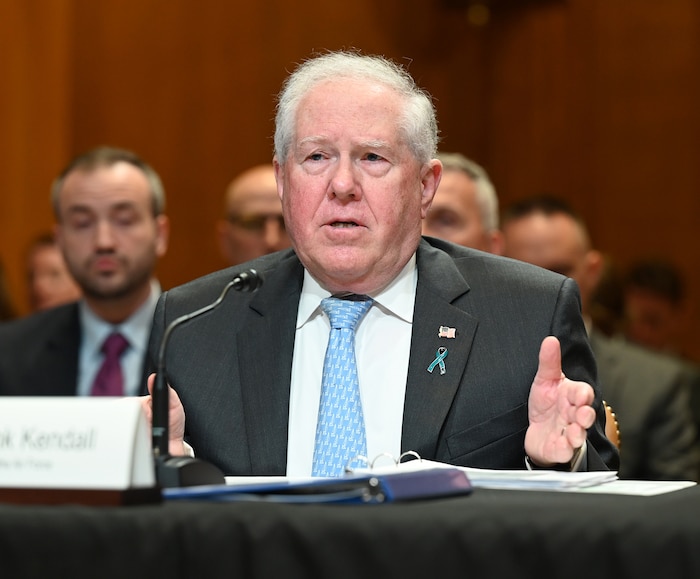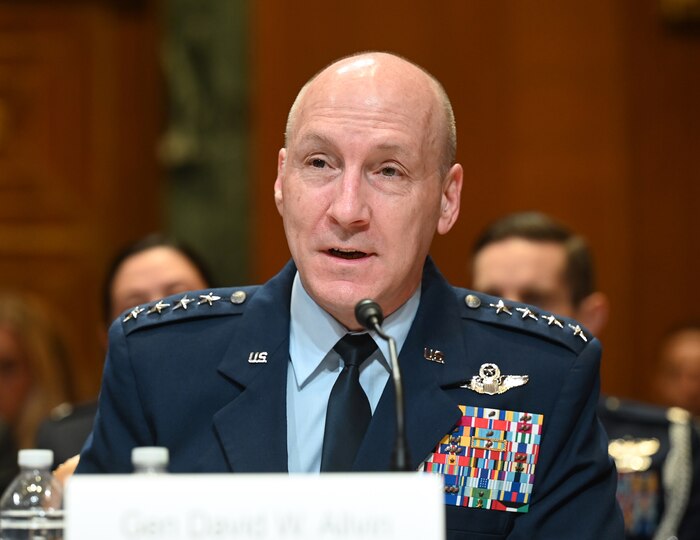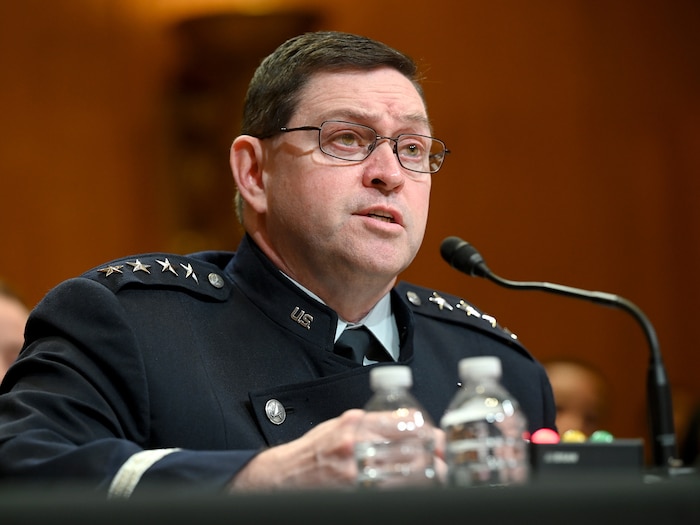Department of the Air Force Secretary Frank Kendall and the department's two highest-ranking military leaders told a Senate subcommittee April 9 that the United States cannot withstand further budget delays if it expects to modernize and compete successfully against China.
"Continued failure to provide on-time authorities and appropriations will leave the Air Force and Space Force inadequately prepared," Kendall told the Senate Defense Appropriations Subcommittee.
"Time matters, but so do resources. The United States is also now facing a competitor with national purchasing power that exceeds our own, a challenge we have never faced in modern times," Kendall said in a hearing which kicked off the lengthy congressional process designed to finalize a federal budget by Sept. 30. Kendall was joined by Air Force Chief of Staff Gen. David W. Allvin and Chief of Space Operations Gen. Chance Saltzman.
Kendall, Allvin and Saltzman's official purpose during the hearing was to explain the department's $217.5 billion budget request for the 2025 fiscal year which begins Oct. 1. They also added insight into what trade-offs were made and how the spending fits into the nation's larger national security strategy and why having a new budget in place on time is critical.
Whatever Congress decides for a final budget amount, all three leaders said that there would be consequences to the nation's security and international standing if Congress fails to approve the budget on time. The budget for the current fiscal year was finally enacted in March, more than six months late.
"As we look across the strategic landscape, we find ourselves in a time of significant consequence," Allvin told lawmakers, adding, "Time is not on our side."
While it is impossible to know the precise path budget considerations will take this year, Subcommittee Chairman, Sen. John Tester, D-Mont., acknowledged the dangers of a delayed budget and agreed with the three senior leaders that a similar history must be avoided.
"At last year's Department of the Air Force hearing, I stressed the importance of getting the budget done on time. We failed. But we don't need to fail this year. We need to get it done and get it done by the end of September, so you guys have the certainty you need and not to waste taxpayer dollars and to make sure the folks who serve under you have every tool to be successful," Tester said.
"Timely enactment of the defense appropriations bill has never been more urgent," Tester said.
By service, the budget proposal directs $188.1 billion to the Air Force and $29.4 billion to the Space Force.
Despite the thousands of individual facets and needs outlined in the Air Force and Space Force budget document, Kendall boiled down the latest budget proposal to a singular focus. The department, "needs immediate and significant capability modernization to keep pace with the growing military capabilities of the PRC," Kendall said, using the acronym for the People's Republic of China.
Like Kendall, Allvin's assessment was not ambiguous. Nor was Saltzman's.
"The (fiscal year) 25 Air Force budget request reflects difficult choices," Allvin told senators.
"We've made tradeoffs to keep the Air Force's operational readiness today at the minimum acceptable to meet the nation's demands, while seeking to preserve the previous years' substantial advances in modernization and procurement. The Air Force budget request also invests in the Air Force's most precious asset - its Airmen - to ensure they remain the decisive advantage upon which the nation depends," he said.
In describing the plans and needs for space, Saltzman was also clear and emphatic.
"Against a near-peer adversary, space superiority is the linchpin. Without it, we cannot deter conflict. Without it, we cannot provide vital effects. Without it, we cannot protect the joint force. Until we have built the infrastructure to achieve space superiority, the Space Force is a work in progress," he said.
"We remain committed to the (sixth generation aircraft) family of systems, particularly Collaborative Combat Aircraft, which will allow the Air Force to deliver the affordable mass required to be effective against the very capable PRC," Allvin said, describing the newest generation of fighter aircraft and a suite of less expensive and autonomous aircraft. "We are also committed to building forward basing resilient enough to enable continued sortie generation, even while under attack."
For space, Saltzman said, "Our budget request is designed to build, train, and equip the forces we need to perform each activity, preserving freedom of action in space while deterring and denying adversarial objectives."
Saltzman noted that the Space Force is by far the smallest of the nation's military services but pointed out that the capabilities it provides and manages are essential to every service's success.
"With only 3% of the (total defense) budget, the Space Force offers a tremendous value proposition to the nation," he told senators. "Every dollar invested in space brings asymmetric returns, but that means every dollar cut creates asymmetric risk."
He itemized in broad strokes the size of the budget as it relates to the service's Theory of Success. The biggest portion, at 43.4 percent, is devoted to ensuring any "first strike against U.S. space capabilities (is) impractical and self-defeating." That is accomplished, he said, by "investing in resiliency for missile warning and tracking; satellite communications; and positioning, navigation, and timing. Hybrid architectures and proliferated constellations impose a hefty cost on aggression."
Saltzman also underscored the importance of the 24.7% of the budget dedicated to space superiority and noted that many more requirements remain unfunded. "We are still maturing into our role as a separate warfighting service, and we have had to make hard choices to maintain legacy space services at the cost of advancing this transformation," he said. "Make no mistake, we will meet the vision for which the Space Force was established, but we must act with a greater sense of urgency."
For the Air Force, the budget includes money to purchase more state-of-the-art F-35s and F-15EXs, "albeit with fewer than preferred quantities," Allvin said. The reduction was triggered by an earlier budget agreement that the White House and Congress negotiated in 2023 that limited to 1% the increase in overall defense spending.
"The DAF (fiscal year) 25 budget request prioritizes nuclear modernization after decades of deferred modernization have left little room for error to maintain a safe, secure, and effective nuclear deterrent," Kendall said.
At the same time, he acknowledged that work would continue on a new version of the land-based intercontinental ballistic missile known as Sentinel despite a 37% cost overrun that has triggered a mandatory review by Congress.
"Notably, the Sentinel ICBM program has experienced unacceptable cost and schedule increases and is currently undergoing a Nunn McCurdy review," he said, using the name of the law that triggers a review when a cost overrun threshold is hit. "The DAF will work closely with the committee as that review reaches its conclusions."
In addition to funding the Sentinel, Allvin said the proposed new budget also includes funding for developing a sixth generation, state-of-the-art system of fighters known as Next Generation Air Dominance and continued development of the Advanced Battle Management System.
That system, Allvin said, "will provide cutting-edge tools and an integrated digital architecture to enable effective C3 Battle Management in contested and degraded environments."
As is common, a variety of topics were raised during the question portion, including those related to recruiting, plans for divesting aging aircraft and systems, supporting Air National Guardsmen currently performing space missions, the status of the new B-21 Raider and its development, how the department is "keeping pace with China's modernization," and the mission capability rates for the F-35 fighter and other aircraft.
On that last question, Kendall acknowledged that the readiness rate for the F-35, the Air Force's top-of-the-line fighter, hovers around 60%. That status he said, is "the minimally acceptable rate" but he expects it to improve.
"We're not where we want to be," Kendall said.
When asked what "the department needs most to achieve strategic objectives" in the competition with China and protect America's interests, Kendall ended the hearing where he began: "Timely appropriations," he said.
"We have given up about a third of the time available over last 15 years when we could have been making progress. We've lost five years in 15 years. You cannot win a race when we move at that kind of pace. … Timely appropriations is critical to success. … We have a reasonable pace of modernization if we're fully funded and promptly funded."









